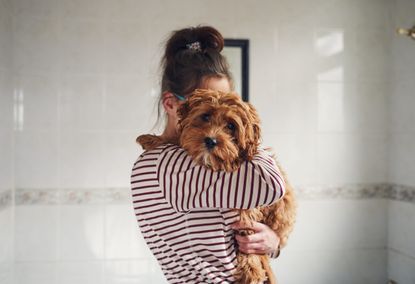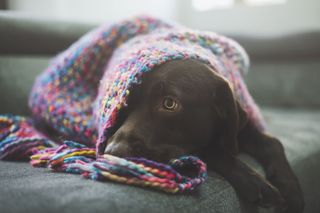Does your dog have separation anxiety? Here's how to tell - and stop it, for good


According to the RSPCA, 8 of 10 dogs don’t cope well when left alone. If your dog gets distressed when you leave them even for a short amount of time, they might be suffering from separation anxiety.
Separation anxiety or separation related behaviour (SRB) as it’s otherwise known, is a common condition in many dogs. Just like humans, dogs are social animals and they have relied on our company for centuries. So it’s only natural that they would get a bit anxious when we're not around.
But while we all know that leaving a dog alone for long periods of time isn’t good, it’s important to be able to go to work or out to do the weekly shop without your furry friend in tow.
Dogs that suffer from separation anxiety will be distressed when they're separated from their owners. Often, it will result in destructive behaviour or reports of howling and barking.
But if you're not around to see it, how do you know if your dog is suffering from separation anxiety? And what can you do to prevent it?

The experts at pet-food brand, Canagan have all the answers we need.
What causes separation anxiety?
As well as being social animals, dogs have a pack mentality. This means they look to an alpha - a dependable figure that's vital for their survival. Out of the wild, that's you. So when they're alone, a dog who has separation anxiety can feel very insecure.
GoodtoKnow Newsletter
Parenting advice, hot topics, best buys and family finance tips delivered straight to your inbox.
MORE: Has your dog piled on the pounds? Here's how they can lose weight
If you've got a puppy or a dog that's been re-homed, it can be especially difficult as they're adjusting to new surroundings. But it's not only new dogs who struggle, as different situations can trigger different responses.
These situations can trigger separation anxiety:
- A change in your schedule: this could mean getting a new job where you're in an office all day, instead of at home.
- Moving house: unfamiliar surroundings can be unnerving for any dog and they might take some time getting used to.
- Sudden absence: anything from someone moving out to a break-up, dogs spend so much time looking up to us, they're bound to notice when someone's gone.
What are the signs?
According to Canagan, the first 15 minutes after you leave the house are the hardest for a dog experiencing separation anxiety.
During this time they might display some odd symptoms, such as a quickened heart rate, heavier panting, increased saliva, and a need to go to the toilet.
After that, they might display the following symptoms:
- Persistent howling, whining or barking
- Causing destruction: anything from scratching at doors to destroying household objects, these behaviours can also cause injury to your dog
- Escaping
- Pacing up and down, or running around in a circle
- Urinating or defecating
After this frenzy, your dog might chew on something that carries your scent. They're also likely to be really excited when you return, following you wherever you go. And if they think you might be getting ready to leave again, they could restart the cycle of panting and pacing.
As much as none of us want to leave our furry friends behind, sometimes it's necessary. So it's important that when we do, they're as comfortable as possible.

How to reduce separation anxiety and create a relaxing environment for your dog
Whether your dog is a puppy, a rescue or an older dog who has slipped into bad habits, it’s never too late for training to give you greater freedom and your dog the confidence to be left alone for longer periods of time.
Decide where you feel comfortable leaving your dog
Most people go for the kitchen, as it’s easy to clean afterwards. By creating a cosy space with ambient noise, at the right temperature with a couple of chew toys thrown in, your dog will start to feel comfortable. You can also leave a piece of clothing you’ve worn recently around, so your scent lingers.
Train your dog for alone time
For your dog to feel comfortable being alone, they've got to feel like nothing has really changed. By familiarising your dog with the feeling of being alone, they will more likely be comfortable with you leaving in the future. Canagan says that stair gates are a great way to do this, as they aren't as intimidating as shutting a door.
To introduce your dog into the habit of staying behind the stair gate, try gradually creating distance first. Stay in the same room so initially they can see, smell and hear you. Then at random points in the day, pop a tasty treat in with them to encourage your dog into that space. Check in on your pet after a while and if they get distracted and sit by you, sit with them for a while quietly. Over a few days, gradually increase the time your dog is left behind the stair gate until they are relaxed enough to be left completely.
Settle your dog before you leave
Just before setting off for work or even a longer trip, make sure they're content to be left. This means taking them for a walk - just like humans, dogs need physical and mental exercise to be calm and live happy lives. And while you're out on that walk, make sure they've gone to the loo too!
If you feed them a small meal, they'll sleep better as well.
As much as you can try to settle them down, some dogs just won't want to settle. If that happens, it's important not to punish them as they won't understand and it will just make them more anxious when you leave again.
Can't beat them? Join them!
Some dogs are just not built to spend time alone and this might be an underlying issue such as depression.
As frustrating as it can be, it might be better to find opportunities to include your pet. This might include taking your pet for a run when you go, asking your boss if you can bring them with you into the office, or even take them on holiday with you!

Grace Walsh is a health and wellbeing writer, working across the subjects of family, relationships, and LGBT topics, as well as sleep and mental health. A digital journalist with over six years experience as a writer and editor for UK publications, Grace is currently Health Editor for womanandhome.com and has also worked with Cosmopolitan, Red, The i Paper, GoodtoKnow, and more. After graduating from the University of Warwick, she started her career writing about the complexities of sex and relationships, before combining personal hobbies with professional and writing about fitness.
-
 I tested the Lakeland Dual Basket air fryer and it made midweek family cooking a breeze
I tested the Lakeland Dual Basket air fryer and it made midweek family cooking a breezeYou can’t go wrong with the dual basket air fryer by Lakeland complete with easy-view windows to ensure burnt food is a thing of the past…
By Jessica Dady Published
-
 Reframing one simple habit could get your sex life back on track after having a baby, new research shows
Reframing one simple habit could get your sex life back on track after having a baby, new research showsMany parents struggle to get their sex life back on track after having a baby, but new research has shown how one simple habit could make all the difference.
By Ellie Hutchings Published